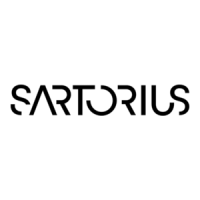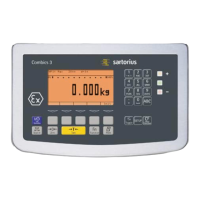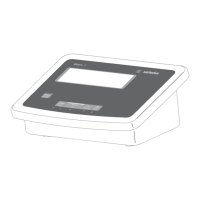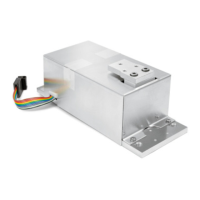Service
Regular servicing by a Sartorius
technician will ensure the continued
accuracy of your indicator. Sartorius
offers service contracts with regular
maintenance intervals ranging from 1
month to 2 years. The maintenance
interval depends on operating condi-
tions and tolerance requirements.
Repairs
! Disconnect defective equipment from
power immediately. Repair work must
be performed by authorized Sartorius
service technicians using original spare
parts. Repairs performed by untrained
persons may result in considerable
hazards for the user. If the equipment
is still under the warranty, send the
entire indicator to the factory for
repairs.
! If a cable or cable gland is damaged
or defective, replace the cable as
a complete unit with all its connectors.
! Do not open the equipment while
it is carrying current. Wait at least
10 seconds after disconnecting it
from power before beginning to open
the equipment. Proper fitting of all
surfaces is essential for the IP rating
of the housing; for this reason the
device must be opened and closed
by a certified technician.
Cleaning
The indicator is designed in compliance
with European Hygienic Equipment
Design Group (EHEDG) directives for
contamination prevention, so that it is
particularly easy to clean and disinfect.
! Unplug the equipment from the wall
outlet (mains supply) and disconnect
any data cables.
! Make sure no liquid enters the indicator
housing.
! Do not use aggressive cleaning agents
(solvents or similar agents).
§ Clean the indicator using a piece of
cloth which has been wet with a mild
detergent (soap).
$ If used in the food industry, use
a cleaning agent suitable for the
particular working environment.
§ After cleaning, wipe down the indicator
with a soft, dry cloth.
! Do not wash down the equipment with
water or dry it with compressed air; this
is not permitted.
Cleaning Stainless Steel Surfaces
Clean all stainless steel parts regularly.
Remove the stainless steel load plate
and thoroughly clean it separately.
Use a damp cloth or sponge to clean
stainless steel parts on the weighing
instrument. You can use any household
cleaning agent that is suitable for use
on stainless steel. Clean stainless steel
surfaces by wiping them down. Then
rinse the equipment thoroughly, making
sure to remove all residues. Afterwards,
allow the equipment to dry. If desired,
you can apply oil to the cleaned sur-
faces as additional protection.
Solvent s are permitted for use only on
stainless steel parts.
Replacing the Dust Cover
$ Replace damaged dust covers.
§ Place the new dust cover on the
indicator and press down on the front
and back along the edges until the
cover is firmly seated.
Safety Inspection
Safe operation of the equipment is no
longer ensured when:
– there is visible damage to the device
or power cord,
– the built-in power supply no longer
functions properly,
– the device has been stored for a
relatively long period under unfavorable
conditions (e.g., excessive humidity), or
– the equipment has been subjected to
rough handling during shipment.
If there is any indication that safe oper-
ation of the device is no longer war-
ranted:
§ Disconnect the equipment from power,
$ Lock it in a secure place to ensure that
it cannot be used for the time being,
and
$ Notify your nearest Sartorius Service
Center or the International Technical
Support Unit based in Goettingen,
Germany.
Maintenance and repair work may be
performed only by authorized Sartorius
service technicians who have access to
the required maintenance manuals
and have attended the relevant service
training courses.
! The seals on the equipment indicate
that only authorized service technicians
may open the equipment and perform
maintenance work; this ensures that
operation of the equipment is safe and
trouble-free and the warranty remains
in effect.
Sartorius products are packaged for
safe shipment using environmentally
friendly materials. If you do not need
the packaging after successful installa-
tion of the equipment, you should
return it for recycling. For information
on recycling options, including
recycling of old weighing equipment,
contact your municipal waste disposal
center or local recycling depot.
If the equipment contains batteries,
make sure to remove them before
disposal. Batteries are hazardous waste
and must be disposed of separately.
Please contact your municipal waste
disposal center for details.
98
Care and Maintenance Recycling

